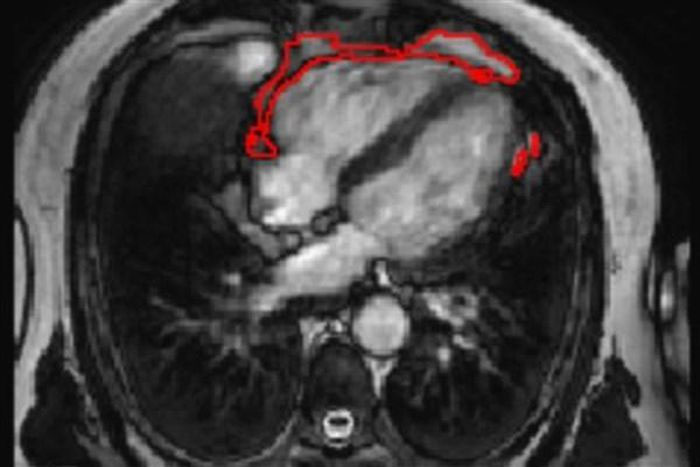AI technology helps measure pericardial fat levels
Fat accumulation around the heart is one of the causes of cardiovascular disease and metabolic syndrome. An example of fat deposits detected by the new instrument.
However, to date, there is no simple method to help measure this condition. Scientists have developed an artificial intelligence tool that quantifies fat deposits from conventional MRI images.
High levels of pericardial fat (PAT) are associated with an increased risk of diabetes and coronary heart disease. However, the association remains a hypothesis due to measurement challenges.

An example of fat deposits detected by the new instrument.
The current best way to measure PAT levels is to use computed tomography (CT) . The problem, however, is that CT scans expose patients to small levels of ionizing radiation. This limits the researchers' ability to measure PAT levels in healthy volunteers.
'To solve this problem, we invented an AI tool that can be applied to MRI magnetic resonance with the heart. As a result, it helps to measure the fat around the heart automatically and quickly, in less than 3 seconds , "said Zahra Raisi-Estabragh, lead researcher.
After training a new neural network, the accuracy of the technology is evaluated using several independent datasets. This tool can indeed accurately measure total PAT volume from cardiac MRI images, the researchers confirm.
To demonstrate the potential of the new tool, the researchers looked at a large UK Biobank dataset of more than 40,000 people. PAT level measurement tool. Then consider the association between PAT and diabetes.
The tool accurately assessed a patient's risk of diabetes based on the amount of fat measured around the heart. That doesn't mean the tool is good for diagnostic testing for diabetes, Raisi-Estabragh notes.
Instead, the tool provides insights into how to effectively investigate the association between disease and PAT levels.
'This tool could be used by future researchers. As a result, discover more about the link between fat around the heart and disease risk. However, there is also the possibility that, in the future, the tool will become part of standard care for patients," added researcher Raisi-Estabragh.
The tool is now ready to be used in new clinical research, the researchers say. This will be the first time that PAT levels can be easily measured in a large group of people.
Steffen Petersen, who supervised the research from Queen Mary University of London, said the tool has the potential to translate into clinical applications. That is possible if further studies clearly confirm PAT measures and disease risk.
- Brain scans to identify and measure pain levels
- Newborn babies are saved by cow's heart
- New technology helps predict earthquakes
- Use pigeons to measure air pollution levels
- Monkeys measure radiation in Japan
- Contact lenses that measure blood sugar
- Treatment of diabetes by injection of nanoparticles
- Means of controlling cell interaction
- How to measure the distance through the center of the Milky Way?
- Technology helps people see the world through animal eyes
- Can measure time without clock
- Detecting miscarriage by testing progesterone levels
 The world's first sexless AI voice
The world's first sexless AI voice This cool t-shirt will make you invisible to AI
This cool t-shirt will make you invisible to AI AI can predict personality only through selfie photos
AI can predict personality only through selfie photos The world-famous chess player lost to Golaxy before, artificial intelligence 'made in China'
The world-famous chess player lost to Golaxy before, artificial intelligence 'made in China'